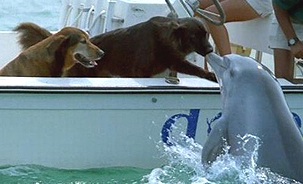by Michael Mountain, founder of Best Friends Animal Society and Zoe Nature
I used to have a Doberman named Sun. He was a delightfully silly dog who loved everyone and just wanted to play. His favorite trick was to run up to people who’d be standing there petrified that they were going to be attacked “by that big dog.” And then he’d sit down in front of them and wait to be petted.
I was reminded of Sun when I saw the story this week of a Doberman called Turbo, who lives on Marco Island in Florida. Turbo is obviously a slightly silly dog, too, just like Sun. He’d wandered out of the gate of his yard, which his person had left off the latch by mistake, and ended up in a waterway that leads out to the ocean.
Turbo is 11 years old – that’s quite old for a Dobey – so he wasn’t going to last long if he couldn’t get out of the water fast. And that was the problem: he couldn’t get out.
When his mom, Cindy, came home and discovered he wasn’t there, she drove around town half the night trying to find him on the street. But Turbo wasn’t on any street; he was running out of steam trying to stay afloat – and with the tide now rising.
But help was at hand.
A woman who lives a little further down the waterway heard some very loud splashing behind her house. She went out and saw a group of dolphins surrounding Turbo and slapping their tails hard on the water to attract attention. Dolphins have big, powerful tails, or flukes, and slapping the water can make a lot of noise – it’s one of their ways of sounding the alert to each other. The neighbor jumped into the water, rescued Turbo, and took him home until she could find where he belonged.
A long history of dolphins protecting us
So why do dolphins routinely go out of their way to make friends with us humans and our pets and protect us from trouble? There are so many stories, dating way back to ancient Greece, of dolphins rescuing people in distress and helping us out when we get into trouble.
One famous report comes from the 1998 South Caribbean Regatta, when a sailor fell into the ocean. The seas were so rough that the rest of the crew lost sight of him. Other boats joined the search, but they couldn’t find him, either. Then people in one of the boats saw two dolphins swim toward them, then swim away, then come back, then swim away again. They kept doing that until, finally the crew got the message: the dolphins were trying to show them where the sailor was.
They quickly followed the dolphins, who led them straight to the floundering man. He was surrounded by a whole group of dolphins who were protecting him.
Why do they help us out when we’re in trouble?
I asked Zoe’s Science Editor, Lori Marino, why the dolphins would do this. Dr. Marino is a neuroscientist and one of the world’s leading experts on dolphins.
“They’re a very social, very caring species,” she explained. “They care for each other in ways that no other species does. So I think when they know that somebody else is in trouble, it’s part of their nature to help.”
In this case, though, it wasn’t a human in the water; it was a dog. How would they know that the dog was in distress? Might they not think he was invading their territory and maybe even trying to attack them?
“They’re intelligent enough to know when someone’s in trouble,” said Dr. Marino. “They’d know the difference, like when it’s a crocodile. But when someone’s in difficulty, no matter the species, and they’re struggling or scared or stressed, then the dolphins can pick up on that, and that’s when they go to help.”
What the dolphins did for Turbo
We don’t know exactly how long Turbo was in the water and how much help he needed. But Dr. Marino says that if he was beginning to sink, the dolphins’ natural response would be to lift him up to the surface.
“That’s what they do when one of their own kind or a dolphin from another species is injured. And mothers do it for their calves to make sure they come up to the surface in enough time to breathe. So they’re just extending their natural caregiving behavior to another species.
Whatever the dolphins did for Turbo, he ended up on a sandbank where he could just keep his head above the water until the tide rose any higher. And that’s when he was found, with the dolphins still circling close by, keeping an eye on him.
I can’t help but add the obvious, which is that while dolphins go out of their way to help us humans and our pets, I don’t know many cases of us helping them out. Quite the opposite, in fact. We do some pretty awful things to them: killing them by the thousands; capturing them from their families and making them perform for us in marine circuses, and keeping them in tanks where we do experiments on them.
Fortunately for us, either the word hasn’t yet gotten around that they should totally steer clear of us, or they’re just very forgiving.
Meanwhile, Turbo is safe and sound, and probably not planning any more trips to the waterway.
Thank you, dolphins!
This article originally published here at zoenature.org.
Michael Mountain is one of the founders of Best Friends Animal Society, the nation’s largest animal sanctuary and one of the pioneers of the no-kill movement for homeless pets. As president of Best Friends and editor of Best Friends magazine, he helped to build grassroots adoption and spay/neuter programs all over the country before stepping down in 2008. He currently is the editor and co-founder of Zoe— a new online magazine for people who care about animals, nature and the environment — and the co-founder of StubbyDog, which is working to change public perceptions of Pit Bulls.









